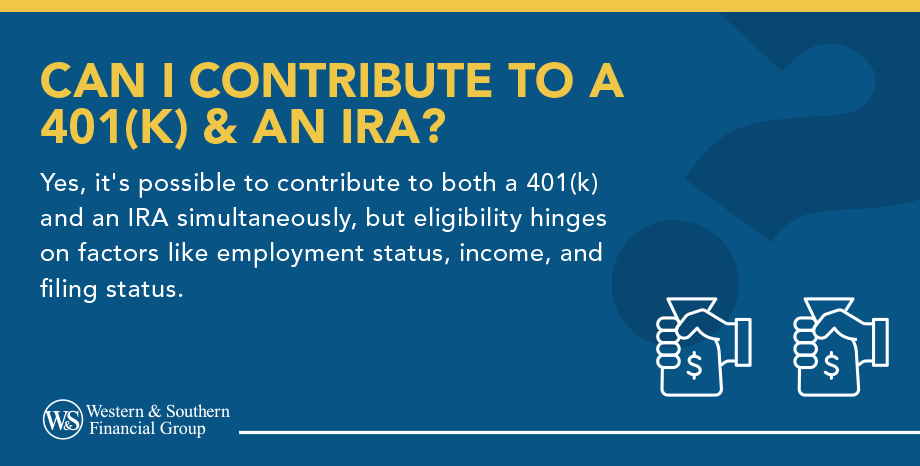

Key Takeaways
- The IRS allows individuals to contribute to both a 401(k) and an IRA at the same time, provided they meet the specific rules for each account.
- Unlike other accounts, 401(k) plans have no income limits for making contributions, making them accessible to high-earners.
- Qualification to contribute to a Roth IRA depends on your income, as your ability to contribute is phased out or eliminated.
- The importance retirement strategy is to contribute at least enough to your 401(k) to receive the full employer matching contribution.
- The choice between Roth and Traditional contributions should be based on whether you anticipate being in a higher or lower tax bracket during retirement.
It can be beneficial to contribute to an IRA and a 401(k) if you qualify, but there are certain rules that could potentially limit you from contributing to both types of retirement accounts at the same time. For instance, while traditional IRAs don't have income limits, Roth IRAs do.
If you're wondering if you can contribute to both a 401(k) and an IRA, here's what to know.
Is It Possible to Contribute to Both Retirement Accounts?
In a word, yes. The IRS allows for individuals to contribute to an IRA and 401(k) at the same time.
But not everyone qualifies to contribute to both types of retirement accounts. While each are similar, there are some differences as well. So, before you get into the details and strategies for contributing to both an IRA with a 401(k), you'll first need to determine if you qualify to contribute to each type of retirement plan individually.
How to Know If You Qualify to Make 401(k) Contributions
Generally, if you're employed and your employer sponsors a retirement plan, you can make contributions to a 401(k). But there are a few qualifying factors for participating in a 401(k):
- Meet the 401(k) plan entry rules: 401(k) plan rules commonly require individuals to be at least 21 years old. In some cases, employees may have to be employed for a certain amount of time before they can enroll in the plan and make contributions.
- 401(k) income limit: Fortunately, unlike IRAs, 401(k) plans have no income limits for making contributions. Therefore, anyone can contribute. However, there are potential rules — such as discrimination tests for highly compensated employees — that could limit your contribution amount below the general IRS limit of $24,500 per year, or $32,500 if you're 50 or older, in 2026.1
How to Know If You Qualify to Make IRA Contributions
Generally, if you have earned income in any given taxable year, you can make IRA contributions. There are no income limits for traditional IRAs, but if your annual income is too high, it's possible you will not qualify to make contributions to a Roth IRA.
Understanding Income Limits for Roth IRAs
| Filing Status | MAGI Contribution Limit | Maximum Contribution (Under Age 50) | Maximum Contribution (Age 50 or Older) |
|---|---|---|---|
| Single/Head of Household | Less than $153,000 | $7,5001 | $8,600 |
| $153,000 to less than $168,000 | Reduced contribution amount | Reduced contribution amount | |
| $168,000 or more | No contribution allowed | No contribution allowed | |
| Married Filing Jointly | Less than $242,000 | $7,500 (for each spouse) | $8,600 (for each spouse) |
| $242,000 to less than $252,000 | Reduced contribution amount | Reduced contribution amount | |
| $252,000 or more | No contribution allowed | No contribution allowed |
Considerations When Contributing to an IRA & a 401(k)
One benefit of contributing to both an IRA and 401(k) plan is to maximize the power of tax deferral. While every personal financial situation is unique, there are a few general rules to follow for contributing to both an IRA and a 401(k):
- Maximize the 401(k) match: If your employer offers a match in your 401(k) plan, you should likely aim to contribute at least enough to receive the match. For example, if the match is dollar-for-dollar up to 5% of compensation, you may want to contribute at least 5%.
- Maximize IRA contributions: If you've already maximized your employer's 401(k) match, try to make the maximum allowed IRA contribution, which is $7,500 per year (or $8,600 if you are 50 or over).1
- Roth vs traditional contributions: Like IRAs, many 401(k) plans allow for Roth or traditional contributions. It's generally wise to make Roth contributions if you expect to be in a higher income tax bracket than you are now when you retire. And if you think you'll be in a lower tax bracket when making withdrawals from your IRA in retirement, traditional contributions may be better.
The Bottom Line
Now that you know how you can contribute to a 401(k) and an IRA, you can rest assured that the IRS won't penalize you for maintaining both types of retirement accounts, as long as you adhere to the rules and regulations. Ultimately, retirement planning strategies for contributing to a 401(k) and a IRA will depend on your personal financial situation. For this reason, it can help to consult a financial professional to get specific advice for your retirement goals.
Strategize your 401(k) and IRA contributions based on your retirement goals. Start Your Free Plan
Sources
- 401(k) limit increases to $24,500 for 2026, IRA limit increases to $7,500. https://www.irs.gov/newsroom/401k-limit-increases-to-24500-for-2026-ira-limit-increases-to-7500.





















